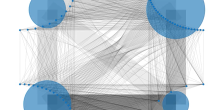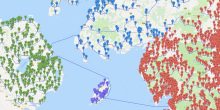In a seminar talk in Cambridge this week, Julian Sahasrabudhe announced that he, together with his colleagues Marcelo Campos, Simon Griffiths and Rob Morris, had obtained an exponential improvement to the upper bound for Ramsey's theorem.
When I opened Twitter this morning I saw a post of mathematician Timothy Gowers sharing this news. In a recently appeared article on arXiv. the authors claimed they have proved that Ramsey number  is smaller than
is smaller than  , for
, for  sufficiently large, and
sufficiently large, and  some sufficiently small positive number.
some sufficiently small positive number.
The authors in the article give two proofs, one for  (a simpler one, still various pages long and quite technical) and one for
(a simpler one, still various pages long and quite technical) and one for  , with a more technical proof. They choose not to optimize the value of
, with a more technical proof. They choose not to optimize the value of  because they prefer to keep the proof elegant and as simple as possible. This is a very noble choice I think, since mathematics is not only about results but mostly about elegance and readability of arguments.
because they prefer to keep the proof elegant and as simple as possible. This is a very noble choice I think, since mathematics is not only about results but mostly about elegance and readability of arguments.
Ramsey numbers
Ramsey numbers are often communicated using the following quiz questions
“Suppose that six people meet at a party. I argue that, whoever these six people are, there are always either three people who all know each other or there are three people who all don’t know each other.”
If you spend some time thinking about it you will see that the answer is easy if you suppose, for example, the trivial cases that all six people either know each other or they are strangers and all don’t know each other. But why does this hold whoever these six people are?
There is an elegant way to rewrite this problem as a combinatorial problem, namely, suppose you have six points and that they are all connected to each other. Suppose you color the edges either red or blue. Then in such a graph there always exists either a blue triangle or a red triangle. If there is no blue triangle there will definitely exist a red triangle and vice-versa! If you start drawing graphs with six points and blue-red lines connecting these points you will see that there is always a triangle (a triangle in a graph is what you expect it to be, three points connected to each other) whose edges are either all blue or all red. It is a little bit more challenging to find an argument why this holds. The following observation can help you find the argument.
To come back to the question about the party, say that each of the six guests is represented by one of the six points in the graph, a red edge between two points indicates that the two guests know each other, and a blue edge indicates that they don’t. This translation shows that the graph problem and the party problem are in essence the same.
This statement does not hold if you consider less than six people/points. This is simple for the case of three or four people, what about five? Think of five people sitting on a round chair and each one only knows the one guest sitting on the left and the one on the right. Then each guest knows exactly two other guests who always don't know each other! You can also think of the colored graph on the right if you prefer a graph-version of this argument. The result I just sketched about parties and graphs corresponds to the Ramsey number  being equal to six. The Ramsey number
being equal to six. The Ramsey number  is thus defined as the minimum number of points needed so that every graph with this number of points, where the edges are colored blue or red, either has a blue triangle or has a red triangle! And this number is six. So
is thus defined as the minimum number of points needed so that every graph with this number of points, where the edges are colored blue or red, either has a blue triangle or has a red triangle! And this number is six. So  .
.

You are probably shaking from excitement to learn why these Ramsey numbers are so interesting, so let’s have a look at this. Intuitively the Ramsey number  corresponds to the minimum number of guests you need to invite to a party to guarantee that there are either
corresponds to the minimum number of guests you need to invite to a party to guarantee that there are either  guests who all know each other or there are
guests who all know each other or there are  guests who all don’t know each other. Be careful, the Ramsey number says that in any group of people of this size this property should hold! Above we explained why
guests who all don’t know each other. Be careful, the Ramsey number says that in any group of people of this size this property should hold! Above we explained why  . In mathematics, the Ramsey number
. In mathematics, the Ramsey number  is defined as the smallest number of points needed so that every possible graph with this number of points either has a so-called
is defined as the smallest number of points needed so that every possible graph with this number of points either has a so-called  -clique or a so-called
-clique or a so-called  -stable set.
-stable set.
k - clique
In a graph a  - clique is a collection of
- clique is a collection of  points such that all edges between these
points such that all edges between these  points are present.
points are present.

k-stable set
In a graph a  - stable set is a collection of
- stable set is a collection of  points such that no edges are present between these
points such that no edges are present between these  points are present.
points are present.
In the picture on the left cliques of size 3,4 and 5.
Well, if you think about this for quite some time it is remarkable what this statement says. It says that all possible graphs you can think of having a specific size either have a collection of  points that are all connected to each other (a
points that are all connected to each other (a  -clique), or a collection of
-clique), or a collection of  points with no edges between any of these points (a k-stable set). A small painful detail missing from my argument is whether the Ramsey number
points with no edges between any of these points (a k-stable set). A small painful detail missing from my argument is whether the Ramsey number  is actually a finite number, because the answer could simply be “Such a number does not exist!”, this would mean that no matter how large the graph gets it will not have neither a k-clique nor a k-independent set! Think what this means in the context of a party. Thankfully these numbers do exist! This result follows from a result Frank Ramsey proved himself in 1930.
is actually a finite number, because the answer could simply be “Such a number does not exist!”, this would mean that no matter how large the graph gets it will not have neither a k-clique nor a k-independent set! Think what this means in the context of a party. Thankfully these numbers do exist! This result follows from a result Frank Ramsey proved himself in 1930.
Unapproachable numbers
Ow, something I forgot to mention, there is a very big issue with Ramsey numbers, they are extremely difficult to compute! Ramsey may have proven that his number  is, for every
is, for every  , finite but what
, finite but what  exactly is, is up to today a huge riddle. We have seen that
exactly is, is up to today a huge riddle. We have seen that  and it is also known that
and it is also known that  (shown in 1969) but is still unknown what
(shown in 1969) but is still unknown what  exactly is. The only result we have managed to obtain is that
exactly is. The only result we have managed to obtain is that  is greater than 43 and less than 48. On Wikipedia there is a famous quote of Paul Erdős showing the complexity of computing Ramsey numbers,
is greater than 43 and less than 48. On Wikipedia there is a famous quote of Paul Erdős showing the complexity of computing Ramsey numbers,
Erdős asks us to imagine an alien force, vastly more powerful than us, landing on Earth and demanding the value of  or they will destroy our planet. In that case, he claims, we should marshal all our computers and all our mathematicians and attempt to find the value. But suppose, instead, that they ask for
or they will destroy our planet. In that case, he claims, we should marshal all our computers and all our mathematicians and attempt to find the value. But suppose, instead, that they ask for  . In that case, he believes, we should attempt to destroy the aliens.— Joel Spencer
. In that case, he believes, we should attempt to destroy the aliens.— Joel Spencer
There is actually a result derived using computers that states that  .
.
If you want to read more about these amazingly interesting numbers we recommed an article published in the Dutch mathematics magazine Nieuw Archief voor Wiskunde, with title “Parties a smidgen smaller”, written by Ross J. Kang. This article is dedicated “in admiration of the life and achievements of mathematician Ron Graham (1935-2020)”. In this article, Ross Kang recollects his time in Hungary visiting Ron Graham in 2006, the year the last major breakthrough concerning Ramsey numbers was set. Another very interesting article was published in QuantaMagazine some time ago. Maybe now there is a new major breakthrough! The article is probably being proofchecked at the moment by peer-reviewers. Until their verdict is out, I will try my best to understand something from this fascinating modern area of research.






